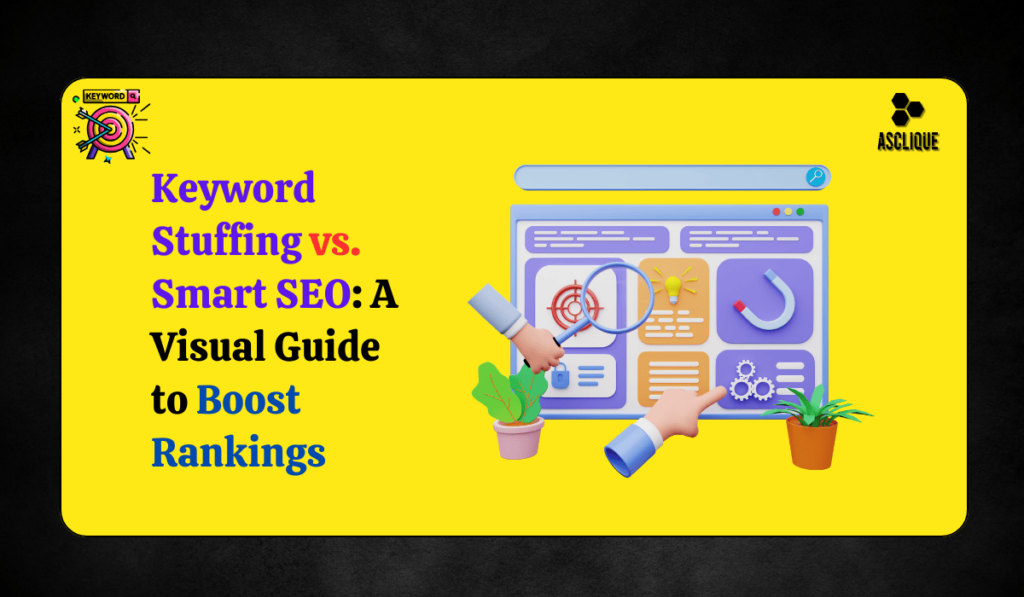SEO is the foundation of online success, but the only constants are changes in search engines. One of the outdated and destructive SEO practices, the old keyword stuffing, is going to destroy your website credibility and rankings. So, what is keyword stuffing and how avoid it? This post will answer all these questions by explaining in deep detail what keyword stuffing is, providing actionable tips on how to avoid a keyword stuffing that still keeps your content relevant and SEO-friendly.
What is Keyword Stuffing?
Keyword stuffing is the use of too many and repetitive or irrelevant keywords on a webpage to manipulate the search engine ranking. It is a black-hat SEO practice that creates flow and readability problems while failing to address the user’s needs.
Types of Keyword Stuffing:
Visible Keyword Stuffing
It is an awkward insertion of keywords into the content, which sometimes makes sentences seem unnatural.
Example:
“If you want to learn what is keyword stuffing, then learning how to avoid keyword stuffing is pretty important, as keyword stuffing can incur you keyword stuffing penalties.”
Hidden Keyword Stuffing
This includes hiding keywords in areas that a user cannot see, such as:
- White text on a white background.
- Hiding keywords inside CSS or HTML codes.
- Inserting keywords in non-viewable parts of a webpage, such as alt text or comment sections.
Why Keyword Stuffing is Harmful?
It would seem that stuffing keywords would bring an easy advantage in ranking high, but keyword stuffing is the only surefire penalty attractor for 2025. Search engines have developed an ability to realize manipulation techniques and rank quality content that fulfills user intent instead. Here are some reasons keyword stuffing is detrimental:
Search Engine Penalty
- Google, as well as other search engines, penalizes websites for engaging in keyword stuffing; this means losing rankings or, worse, disappearing from search results.
Bad User Experience
- Keyword-stuffed content is not only difficult to read but also annoying, which pushes visitors away. This raises the bounce rate and reduces engagement metrics.
Loss of Credibility
- If your content is repetitive or irrelevant, users will lose trust in your brand. Long-term success requires credibility.
Missed Revenue Opportunities
- Instead of solving problems or answering queries, stuffed content alienates potential customers, resulting in lost leads and conversions.
How to Avoid Keyword Stuffing in 2025
Understanding how to avoid keyword stuffing involves striking a balance between strategic keyword placement and high-quality, user-focused content. Here are 10 proven tips below:
Quality Over Quantity
- Quality content resonates with readers and meets search intent. Write naturally and use keywords where they fit well.
Reasonable Keyword Density
- A keyword density of 1-2% is perfect. For a 1500-word article, this means using your keyword 15-30 times. Tools like Yoast SEO can help monitor density.
Use Synonyms and Related Terms
- Instead of repeating keywords like how to avoid keyword stuffing, use variations such as “ways to prevent keyword stuffing” or “optimizing keyword usage.”
Use Latent Semantic Indexing (LSI) Keywords
- LSI keywords are related phrases that enrich content. For instance, besides what is keyword stuffing, you can use phrases such as “SEO optimization mistakes” or “Google ranking factors.”
Prioritize User Intent
- Write with your audience in mind. Focus on answering their questions or solving their problems, and keywords will naturally fit into the flow.
Strategic Keyword Placement
Incorporate keywords in:
- Headings: Ensure subheadings include relevant keywords.
- First 100 Words: This makes search engines understand the topic of your content.
- Meta Tags: Use keywords naturally in titles, descriptions, and alt text.
- URLs: Keywords in the URL increase relevance.
Value to Readers
- Always give value. Use examples, anecdotes, and actionable tips that are beyond surface-level explanations.
Use Structured Data
- Schema markup makes it easier for search engines to understand your content without relying on keyword repetition.
Track Content Performance
- Use Google Analytics to track user engagement. If the bounce rate is high, it could be due to low-quality content or keyword stuffing.
Content Update
- Update older articles to make them comply with the current SEO standards and search engine algorithms.
The Evolution of Keyword Usage: What’s Changed in 2025?
Search engines get smarter, and so do SEO strategies. Here’s how keyword usage is evolving:
How AI Changes Search Algorithms
- Google’s AI systems, such as BERT and MUM, are familiar with the natural language system less often, and therefore do not require any repetition of keyword matches.
E-A-T Principles
- Ranking now depends greatly on three parameters of Expertise, Authoritativeness, and Trustworthiness, while keyword stuffing contradicts the principles.
Voice Search How End
- The queries for voice searches are conversational, which requires long-tail keywords and natural phrasing.
- Example: Instead of “how to avoid keyword stuffing,” a user might ask, “How do I use keywords naturally in my content?
Understanding how to avoid keyword stuffing is only one part of writing content that performs well. Here are a few bonus tips:
Craft Engaging Introductions
- Hook your audience from the start with an interesting fact, question, or statistic.
- For example: “Did you know that over 75% of search engine penalties are due to manipulative tactics like keyword stuffing?”
Add Visual Elements
- Incorporate infographics, videos, and images to make your content visually appealing. Use alt text wisely for SEO without stuffing keywords.
Use Internal and External Links
- Links to relevant internal pages and authoritative external sources should be added to increase credibility and enhance the user experience.
Encourage Engagement
- End your articles by asking the viewers to comment on, share or check related sources.
Conclusion
Keyword stuffing is never considered an appropriate way of conducting an SEO; otherwise, keyword stuffing would severely destroy your ranking as well as the trust with your viewers. Understanding this perfectly and utilizing proper SEO practices that are highly followed today would assist you to get quality content suitable for reading for your audiences, as well as search engines.
In 2025, successful SEO is about creating value, maintaining relevance, and putting user intent at the heart of your strategy. Keyword stuffing should be avoided, and instead, quality, strategic placement of keywords, and keeping up with the latest SEO trends should be maintained. This approach will not only improve your rankings but also build lasting trust with your audience.
Also read: Best SEO Keyword Research Tool
FAQ’s
What are the signs of keyword stuffing in content?
A: Keyword stuffing usually leads to the repetition of unnatural sentences or irrelevant words.
What effect does keyword stuffing have on search engine rankings?
A: Keyword stuffing leads to penalties from search engines, Google, which may remove your website from the search results or drop your rankings.
Does keyword stuffing occur in meta descriptions?
A: Yes. Piling keywords in meta descriptions makes them spammy and unattractive.
Is the use of synonyms considered keyword stuffing?
A: No, using synonyms and related terms adds depth to your content and makes it rank for multiple variations of a keyword.
What are some tools that I can use to monitor keyword usage?
A: Tools such as Yoast SEO, Surfer SEO, and SEMrush help you track keyword density and the overall optimization of your content.

